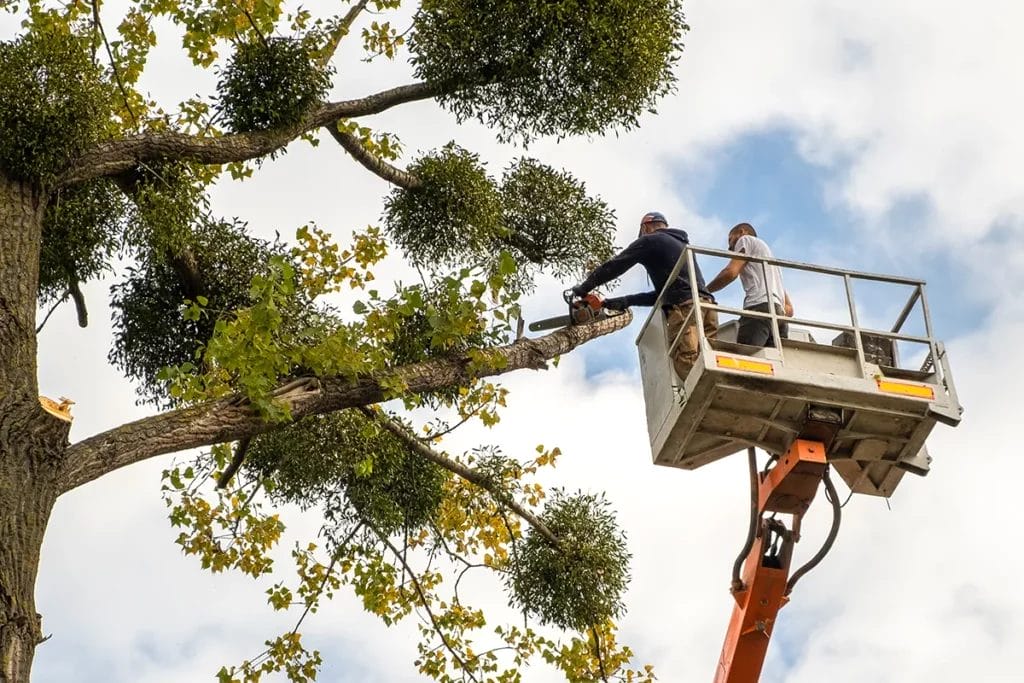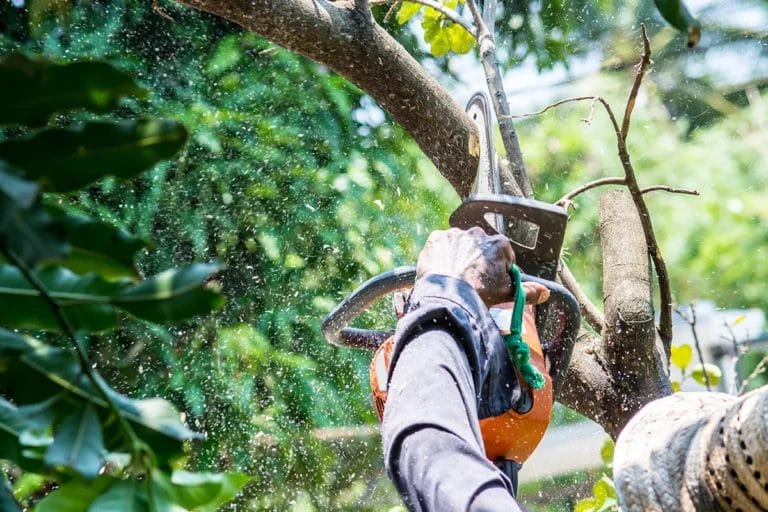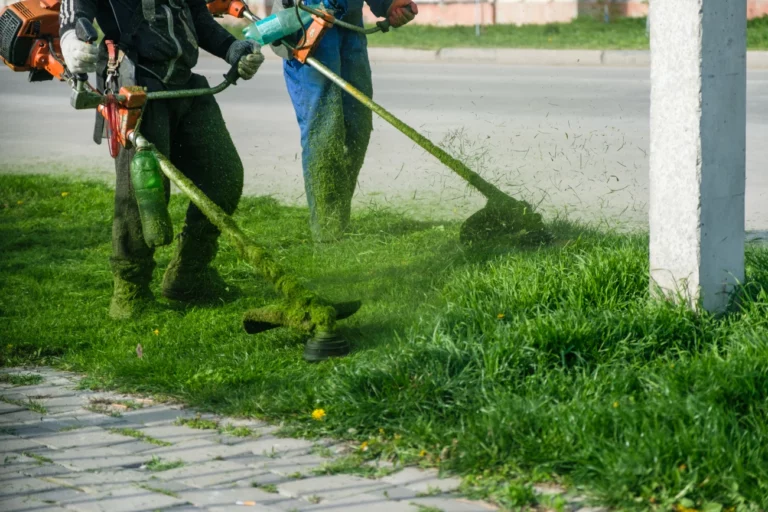If you’re learning how to start a tree trimming business, now is a great time. The industry is showing strong signs of growth, and the need for skilled professionals is higher than ever.
Property owners are investing more in maintaining healthy, safe trees. Demand for emergency cleanup and storm recovery is growing across the country.
Plus, homeowners and municipalities are turning to tree experts for help as urban forestry expands.
Pro Tip: You’ll need tailored tree service insurance from day one. Tree work is high-risk, and insurance protects your equipment, business, and bottom line.
What You Need to Start a Tree Service (Skills, Tools, and Legal Setup)
Did You Know?
- The tree care industry is expected to grow by over 5.2% annually from 2023 to 2030*
- Increasing weather volatility drives up demand for emergency and storm-related services*
- Homeowners are prioritizing curb appeal, increasing calls for regular pruning
Ensure You Have the Right Skills and Certifications
Tree care is one of the most physically demanding and high-risk industries. Training is critical for both safety and credibility with clients.
Start with Occupational Safety and Health Administration (OSHA) training. It teaches job site protocols, fall prevention, and proper equipment use.
Consider enrolling in arborist training programs through local colleges or industry organizations. These courses cover tree biology, disease identification, and pruning techniques that lead to better outcomes and higher rates.
Here are a few arborist training programs you might consider:
- International Society of Arboriculture (ISA) Certified Arborist Program
- Tree Care Industry Association (TCIA) Tree Care Academy
Understand Tree Trimming Business Costs
One of the first things to determine is your startup budget. Startup costs vary depending on your location, business scope, and whether you’re buying new or used equipment. Expect to spend several thousand dollars before landing your first job.
Most solo operators spend $10,000 to $50,000 to get their business off the ground. If you’re planning to handle large removals or stump grinding, you’ll also need a truck, trailer, and possibly a chipper, which can increase costs significantly.
Here’s a quick breakdown of common startup costs:
| Equipment | Estimated Cost |
|---|---|
| Basic equipment and gear | $6,000+ |
| Truck and trailer setup | $30,000+ |
| Business registration and licensing | $75 to $400 |
| Insurance and permits | $600 to $2,000 / year |
Tips for Reducing Startup Costs
Startup capital can be a significant hurdle, but there are several ways to reduce upfront expenses without sacrificing professionalism or safety.
Buying used equipment, especially chainsaws, pole saws, and trailers, can cut thousands from your initial costs.
You can also lease larger equipment like wood chippers or stump grinders until you can afford to buy them. Focusing only on tree trimming and pruning, especially in your first few months, helps minimize what you need to operate safely and legally.
Build In Costs for Fuel, Repairs, Marketing, and Insurance
Plan ahead by building essential operating costs into your job quotes.
Fuel, routine repairs, and blade replacements are ongoing, and skipping them affects your efficiency and safety. Always track those expenses and factor them into your pricing structure.
Don’t forget marketing costs, either. Even if you’re relying on word-of-mouth, you’ll still need a logo, some signage, and an online presence. Budget for digital ads or local promotions to build awareness quickly.
Lastly, factor in annual insurance premiums. You’ll need general liability insurance from day one, and if you’re using gear, trailer and equipment insurance is a smart add-on.
This protects your investment and allows you to win contracts with property managers or city jobs.
Tip: Tree service insurance can include a mix of coverages each with different limits and exclusions. Comparing tree service insurance side-by-side can help you spot what’s actually included (or missing) before you commit.
Invest in Equipment and Tools
Tree service professionals rely on gear every day. Without the right tools, jobs take longer and carry more risk.
Start with essential cutting equipment like chainsaws, pole saws, and stump grinders. These tools need frequent maintenance, so factor in upkeep costs as you build your tool inventory.
Plus, don’t forget your safety gear! You’ll need helmets, gloves, eye protection, harnesses, and durable work boots. Trucks, trailers, and loading equipment also help you transport debris and larger logs quickly and legally.
Determine Your Legal Setup and Business Structure
Your business must be legally registered before taking on clients. This protects you by separating your personal assets from your business liabilities, reducing your risk if something goes wrong, like a lawsuit or debt.
It also allows you to operate officially in your state or city, which is often required to get insurance, permits, or licenses.
First, choose a business structure — most tree services register as a limited liability company (LLC) to separate personal and business assets. Other options include sole proprietorships or corporations.
Next, apply for an Employer Identification Number (EIN) through the Internal Revenue Service (IRS). Then, register your business locally and apply for any permits or licenses required in your area.
Pro Tip: Quote each job with your total costs in mind — not just your time on site. That’s the key to long-term profitability.

Develop Risk Management Procedures
Tree work is one of the most hazardous industries in the service sector. It involves climbing, cutting heavy branches, working near power lines, and operating dangerous equipment — often at height and in unpredictable weather.
One mistake can lead to severe injuries, property damage, or even death.
Even on small jobs, risks include falling limbs, malfunctioning gear, unstable ground, and shifting tree weight. Storm cleanup adds additional hazards like downed wires and weakened trunks.
Because of these dangers, proper risk management isn’t optional — it’s essential for keeping your crew and your business protected.
Creating a safety-first culture from day one helps reduce the chance of injury and costly job-site incidents.
- Create daily safety routines
- Inspect gear before leaving the yard
- Walk the site to flag electrical lines, weak branches, or unstable ground
- Check weather conditions and delay work during wind, rain, or lightning
- Maintain reliable equipment
- Check harnesses, helmets, gloves, and boots for wear or damage
- Inspect chainsaws, pole saws, and stump grinders for proper operation
- Test communication devices to ensure they work across the team
- Establish clear safety protocols
- Outline emergency response steps for injuries or hazards
- Train your team on proper chainsaw handling and positioning
- Use consistent team signals to stay coordinated on-site
Pro Tip: Without tree service insurance, a single job-site mistake could cost you thousands. For example, if a falling limb damages a customer’s parked vehicle, general liability insurance helps pay for repairs and protects you from out-of-pocket legal expenses.
Tips to Kickstart Your Tree Service Business
Starting strong means building smart systems from the beginning. How you hire, price, and promote your business has a significant impact on long-term success.
You don’t need to master everything at once, but these business-building habits help you compete with more established crews and earn repeat business.
Hire Qualified Workers
Tree work requires skill, strength, and a focus on safety. Hiring experienced workers helps you complete jobs faster and avoid costly mistakes.
If you’re just starting out solo, bring in part-time ground crew or subcontractors when needed. As you grow, consider hiring certified arborists to expand your services.
Develop a Thoughtful Pricing Strategy
Pricing isn’t just about what competitors charge. It should reflect your labor, overhead, risk, and the value you bring to clients.
Quote each job carefully and include costs for fuel, wear on tools, disposal fees, and travel time. Avoid racing to the bottom — quality service justifies fair rates.
Build Relationships With Property Managers
Property managers can give you consistent work year-round. They manage multiple sites and need trusted partners who respond quickly and understand how to keep their properties clean, safe, and compliant.
Reach out directly and offer a free consultation or estimate. Be available during storm season — this is when trust is built.
If you can clear debris fast or safely remove fallen branches after a storm, you’re more likely to get added to their go-to vendor list.
Carrying active insurance coverage also makes you more appealing to property managers. Many won’t even consider vendors without general liability coverage and proof of insurance on file.
It shows you’re professional, prepared, and serious about protecting both your business and theirs.
Pro Tip: Ask if the property manager requires additional insured status; adding them to your policy could help you close the deal faster.
Track Expenses and Cash Flow Weekly
Monitoring your income and spending helps you stay profitable and avoid debt. Use basic accounting tools to stay on top of every dollar earned and spent — including job materials, fuel, gear repairs, and part-time labor.
Create weekly reports to check cash flow, see which jobs were profitable, and make smarter business decisions moving forward.
If you’re consistently underpricing certain services or spending more on equipment repairs than expected, this is where you’ll catch it.
Regular tracking also helps you plan for quarterly taxes and insurance renewals. When your numbers are updated weekly, you’re less likely to run into surprise costs that hurt your bottom line.
Pro Tip: Tracking your expenses makes it easier to justify your pricing to clients and builds a solid case for your value when bidding on larger jobs.
Advertise Your Services
Start with low-cost, high-impact marketing.
Claim your Google Business Profile and get listed in online directories. Ask happy customers for reviews. Use yard signs, logo decals on your truck, and door-to-door flyers in your neighborhood.
Over time, invest in a basic website and Google Ads to reach more clients.

Instant Tree Service Insurance You Can Rely On
One critical step in starting a tree service business is securing the right insurance. One wrong cut or equipment failure can lead to thousands in property damage or injury claims.
With Insurance Canopy, you get affordable coverage in minutes, starting at just $31 per month. Our policies are built for tree trimming, pruning, and removal businesses.
Get protection against third-party property damage or injury claims and receive your Certificate of Insurance (COI) instantly.
Plus, if you want more protection, you can customize your policy with add-ons like equipment coverage (aka inland marine) or increased coverage limits for high-risk projects.
Questions About Starting a Tree Service Business
What type of insurance does a tree service business need?
You’ll need general liability insurance to handle third-party injury and property damage. Add trailer and equipment coverage to protect your gear. If you hire employees, workers compensation is required in most states.
Tip: Curious about the details? Our tree service insurance guide explains each coverage type and how to pick what’s right for your business.
Is my equipment covered if it's stolen from a job site?
If you have trailer and equipment coverage, yes. Your chainsaws, grinders, and hand tools are typically covered if they’re stolen or damaged while on the job site or in your truck.
Can I get coverage the same day I apply?
Yes. Insurance Canopy offers same-day coverage for tree service businesses. You can apply online, download your COI, and start accepting jobs within minutes.
Please note: We currently offer tree service insurance with options such as general liability, trailer and equipment, workers compensation, additional insureds, cyber liability, and commercial auto. Other types of coverage mentioned in broader industry articles may not be included.
*Sources: DataCatalyst, Arborgold

Kyle Jude | Program Manager
Kyle Jude is the Program Manager for Insurance Canopy. As a dedicated program manager with 10+ years of experience in the insurance industry, Kyle offers insight into different coverages for small business owners who are looking to navigate business liability insurance.
Kyle Jude is the Program Manager for Insurance Canopy. As a dedicated program manager with 10+ years of experience in the insurance industry, Kyle offers insight into different coverages for small business owners who are looking to navigate business liability insurance.





